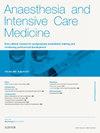麻醉时眼睛的护理
IF 0.3
Q4 ANESTHESIOLOGY
引用次数: 0
摘要
本文描述了与手术室和重症监护环境相关的眼睛护理和可能表明眼睛损伤的临床体征。危险因素,损伤机制,识别和管理常见和重要的眼损伤进行了讨论,以及良好的实践要点和预防措施有关的麻醉师。眼部感染的迹象,重症医师应该警惕,被强调。外伤患者的眼部损伤,需要及时评估和管理视力威胁的条件,也进行了讨论。本文章由计算机程序翻译,如有差异,请以英文原文为准。
Care of the eye in anaesthesia
This article describes care of the eye and the clinical signs that may indicate injury to the eye, relevant to the operating theatre and intensive care environments. Risk factors, mechanisms of injury, recognition and management of common and important eye injuries are discussed, as are good practice points and preventative measures pertinent to anaesthetists. Signs of ocular infection, that intensivists should be vigilant for, are highlighted. Ocular injury in the trauma patient, that requires prompt evaluation and management of sight-threatening conditions, is also discussed.
求助全文
通过发布文献求助,成功后即可免费获取论文全文。
去求助
来源期刊

Anaesthesia and Intensive Care Medicine
ANESTHESIOLOGY-
CiteScore
0.50
自引率
0.00%
发文量
152
期刊介绍:
Anaesthesia and Intensive Care Medicine, an invaluable source of up-to-date information, with the curriculum of both the Primary and Final FRCA examinations covered over a three-year cycle. Published monthly this ever-updating text book will be an invaluable source for both trainee and experienced anaesthetists. The enthusiastic editorial board, under the guidance of two eminent and experienced series editors, ensures Anaesthesia and Intensive Care Medicine covers all the key topics in a comprehensive and authoritative manner. Articles now include learning objectives and eash issue features MCQs, facilitating self-directed learning and enabling readers at all levels to test their knowledge. Each issue is divided between basic scientific and clinical sections. The basic science articles include anatomy, physiology, pharmacology, physics and clinical measurement, while the clinical sections cover anaesthetic agents and techniques, assessment and perioperative management. Further sections cover audit, trials, statistics, ethical and legal medicine, and the management of acute and chronic pain.
 求助内容:
求助内容: 应助结果提醒方式:
应助结果提醒方式:


